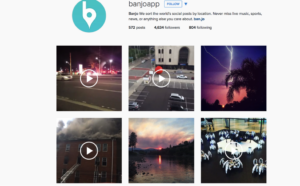Companies are sucking up data and using it to find out everything they can about whatever it is they care about. So far, it’s been a way one deal: data flows from us and into the monster maw of enterprise servers. Banjo has it both ways.

We didn’t really expect to be thinking about big data at our recent visit to V2V, an SXSW spinoff for the start up community but we were taken aback by Damien Patton’s talk about his company Banjo. Patton’s company is based in Las Vegas and he was at last year’s SXSW. At the time, he earnestly explained why Banjo can be at the epicenter of every world event. He described his product as a natural on the ground reporter for rock concerts because absolutely everyone raises their camera and takes a shot. He also described his fondness for going out in the desert and driving anything with wheels and an engine really really fast. At the time, I didn’t really get the point. Probably, any time Patton is in a business situation he’d rather be in the desert and he’ll certainly tell you about it. His interest in posting photos in a social context probably grew out of his adventures, but his enlightenment seems to have come in bright lights of investor meetings and conferences.
Patton came to SXSW V2V 2015 after an earlier visit to the main SXSW conference where he brought his product, a social app based on photos in 2011 that he developed to win a hackfest. Almost as soon as he hit the ground he said, he realized his product wasn’t good enough, it was one in a crowd. It got a respectful pop from the press and users as an app that took note of location and could communicate what photos were being taken nearby. He told investors he needed to go back to the drawing board.
At V2V Patton said Banjo really got its start at the Boston Marathon bombing when a flood of pictures came in around the event and the Banjo team realized all the images could be analyzed to learn more about what was happening on the scene. Patton called the capability a crystal ball and asked who wouldn’t want a crystal ball. The company has added a subscription service that it’s selling to organizations that need information fast like financial houses, analysts, news organizations. In May, the company announced that Japanese investors Softbank led a series C round of funding adding up to $100 million. Banjo is using the money to improve its image recognition capabilities and big data analysis.
The company has divided the world up into a giant grid where with 35 billion squares. Each of those squares are analyzed and described and watched so that when something unusual happens, the Banjo crystal ball can zoom in and start gathering data. Machines do the heavy sifting and humans get involved to assess what’s going on. As the company builds its capabilities, it says it needs less and less human intervention.
Banjo says it caught word of the downing of a Malaysian airplane in the Ukraine almost as soon as it happened. A look at the app right now reveals a car bomb in Kabul, a plane crash at a UK air show, and protests in Beirut. These aren’t pretty pictures, but they’re immediate.
Perhaps one of the best lessons from going to one of these startup conferences is finding out that you’re just part of the herd instead of an innovator. Patton said, one of the hardest things he’s ever done was to go back to investors and tell them he was scrapping the original idea and revamping. At the time, he wasn’t even sure what he was revamping to but he told the audience at V2V the was that in his heart he knew the original app wasn’t the breakout product he set out to create when he started teaching himself how to program.
Out in the world
Patton’s business plan takes advantage of people’s love for taking pictures and posting them and he gives people something back. They can see their pictures trending and see what pictures others have taken but his business is a big data play that tracks trending information and packages it. The company says that some customers pay to monitor information about themselves – to see where their products show up in photos and whether the perception is negative or positive. Others are hunting news trends. Still others are looking for information that will move markets. The advantage Patton has over news sources is that it’s ground sourced and it’s real time.
The company is unique in the way in which it has tapped into a common resource, photos, and that it is able to share the data with consumers for entertainment and news, while it’s also able to add a premium for analysis.
In other big data imaging applications, IBM’s Watson is gathering visual medical data from X-Rays. Analytics can help spot trends, perhaps Watson will learn to more readily identify conditions not obvious to single radiologists. IBM says the visual data from X-Rays is just a start. Watson is hungry for all kinds of medical data and hopes to build a database of information that will help improve health care and medical research. And yes, all that day is valuable.
We’re going to be seeing a lot more of this sort of thing. It’s getting easier to feel the glass walls of the Matrix cocoons closing in, isn’t it?





